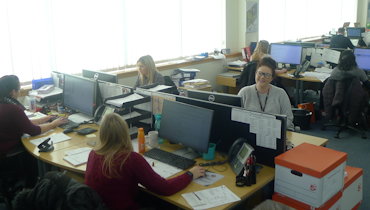Sam writes:
I’ve just been on a very interesting course on the future of finance leadership run by CIMA (the Chartered Institute of Management Accountants).
The traditional view of a finance department is that they are gatekeepers and “just exist to make spreadsheets”. People assume we’re inward-looking, with a set of rules that we impose on everyone else, and that we’re driven by numbers rather than operational reality.
But we’re actually here to provide a service for the company – and if you charged out what we do, you’d see how we add value. (A bit like IT and marketing!)
Why we sometimes fail
Sometimes we go into too much detail. And a lack of time can make it harder to do things properly.
Ideally, we should be providing fast, relevant information. We should help managers to see patterns and trends to help them make the right strategic decisions. We can see which business sections are creating value and which should be trimmed because they’re not adding value. Our reports help managers to identify which costs are good investments, and which costs should be cut. It’s all to help managers to focus on the things that are making money.
Value-focused leadership
Our role is to help managers focus on value. We are better placed than any other department to lead the way for the entire organisation regarding value creation, because we have such a clear insight into all the other sections of the business.
We can act as influencers, as catalysts, and work as a partner with other groups.
What finance reports tell managers
Every company produces reports, including balance sheet, profit and loss, sales / turnover, gross margin, overheads and profit. What do these terms mean, and how do they help managers to make good decisions?
Turnover
This is the same as sales (generated by selling a product or providing a service)
Gross margin
The difference between your sales and the cost of sales is your gross margin ie sales less direct costs. Cost of sales means how much it costs to make the sale. For a manufacturing company it would include labour, plant, and raw materials in your factory. In a service industry such as ours, cost of sales includes wages, pension, National Insurance, PPE (personal protective equipment like boots and high-visibility clothing), training and transport.
Most businesses report gross margin as a percentage of their sales.
The ideal percentage depends on the industry. It could be 5% or 50%. Exclusive brands like Louis Vuitton may have a gross margin of 80 – 90%: they can dictate their price! We are in a high volume business with strong competition, so we can’t dictate our prices, and our margins are generally low.
Operating profit
Operating profit (before or after tax) is gross margin less overheads
Indirect costs like the cost of the finance, HR, IT and marketing team, and the cost of the head office building, are overheads.
You need to note whether you are measuring operating profit before or after tax, of course, because corporation tax is about 20%, depending on the rules.
Net profit is operating profit after tax.
Value Added Tax (VAT) is different. You have to charge that to the customer when it is chargeable – and it goes straight to the tax man.
Cashflow forecast
For a company to be financially viable, it has to meet certain criteria. You have to achieve a minimum gross margin, maintain healthy cash flow and good credit control to make sure all the debts are collected on time. That means the company will have sufficient cash to finance its operations.
A cashflow forecast will help managers to see if that’s working well – or not.
Balance sheets, and profit and loss statements
A profit and loss statement is a quick snapshot to show the board of directors how well the company is doing. It indicates if the directors need to make changes to the business strategy, to make sure they stay profitable – and stay in business.
A balance sheet is a statement of a company’s assets (what it owns) and liabilities (what it owes).
The balance sheet indicates the financial viability of the business at a certain point in time.
How does it work?
So for example, Lucy in Peanuts sells home-made lemonade on the street for 5 cents a glass.
- Turnover is how many 5 cents she gets in any particular time period.
- Cost of sales is how much she paid for the lemons.
- Overheads are how much it cost her to build her little booth.
- Her net profit is what she can take home after paying for her booth and her lemons. (She probably doesn’t pay tax, but we do!)
- Her balance sheet will help her to understand whether the business is financially stable.
- Her profit and loss statement will help her to decide if she needs to raise the price of her lemonade. Or even try selling advice instead!

Are you good with numbers?
You’ve read this far, so you must be interested in how a business manages its finances.
If you’re looking for an interesting career in construction, consider quantity surveying or estimating. (An estimator works out how much a construction project will cost, to ensure the company can make a reasonable profit. A quantity surveyor will manage the costs of a job to make sure it does make that profit.)
If you are an estimator or quantity surveyor, we’d like to hear from you. We’re always looking for good candidates, so please fill in our register for work form.
